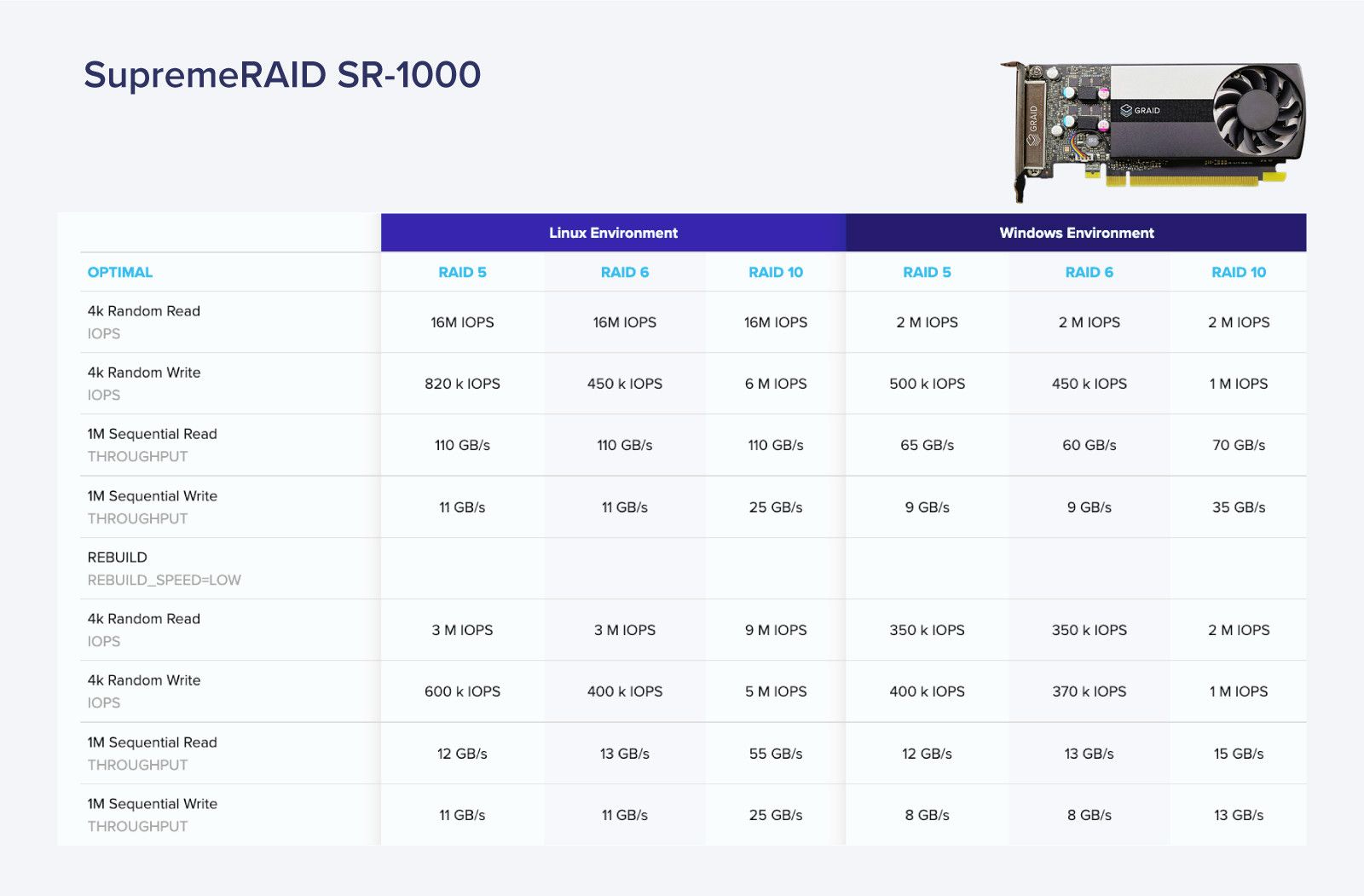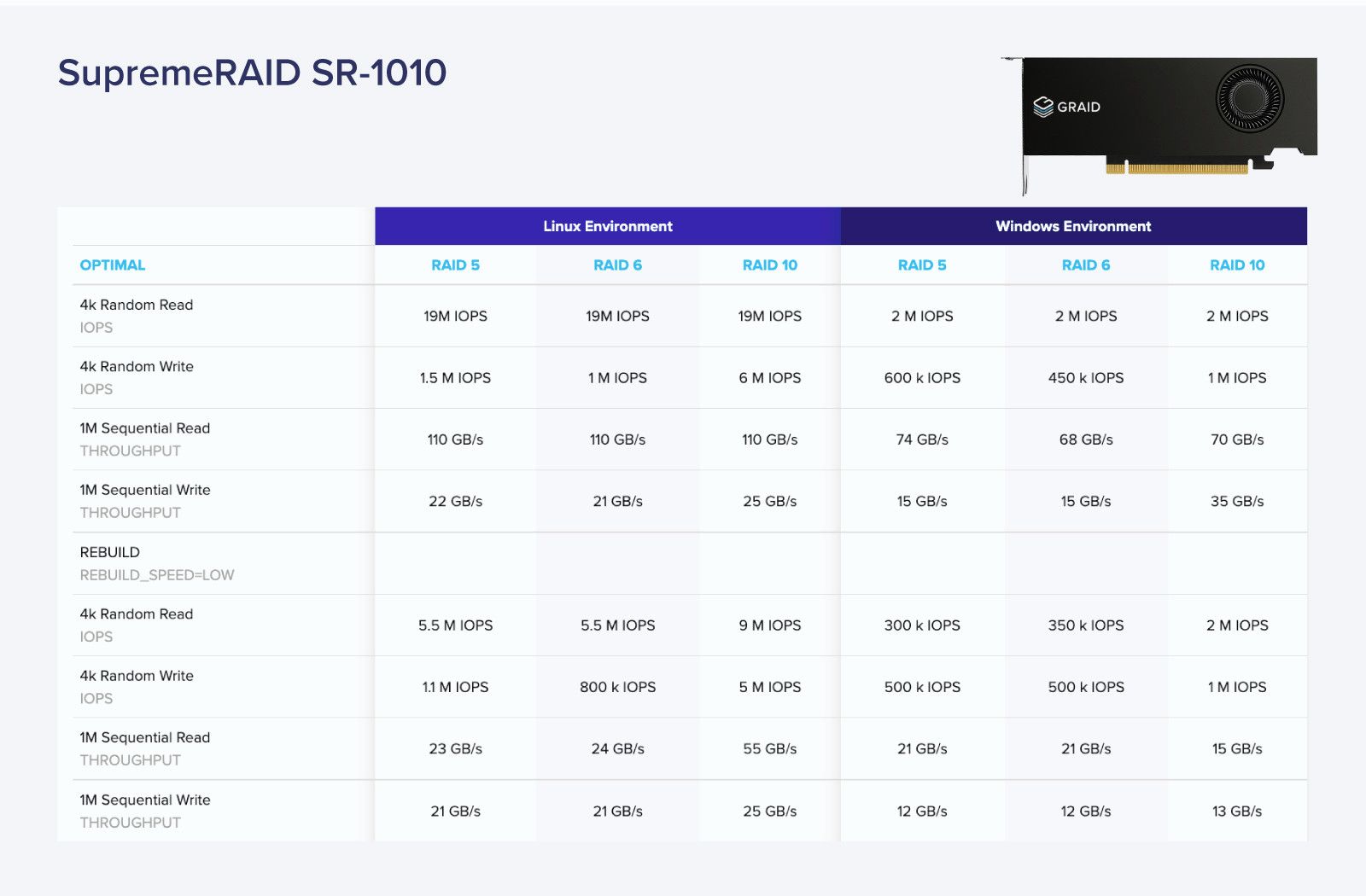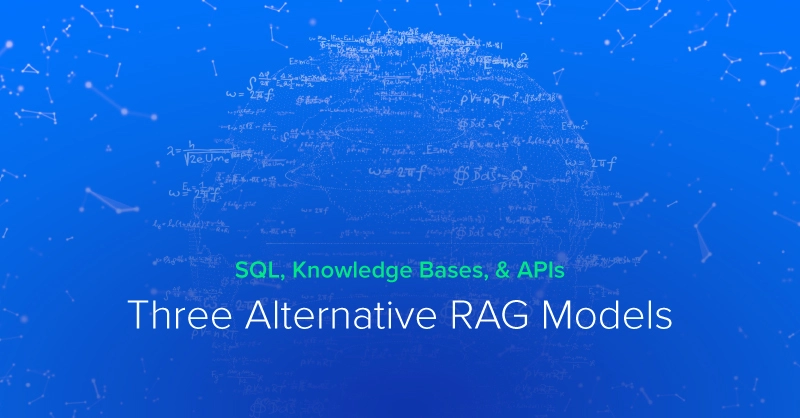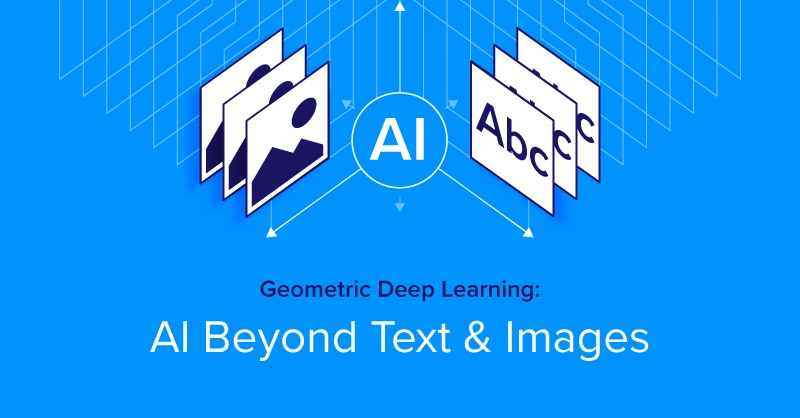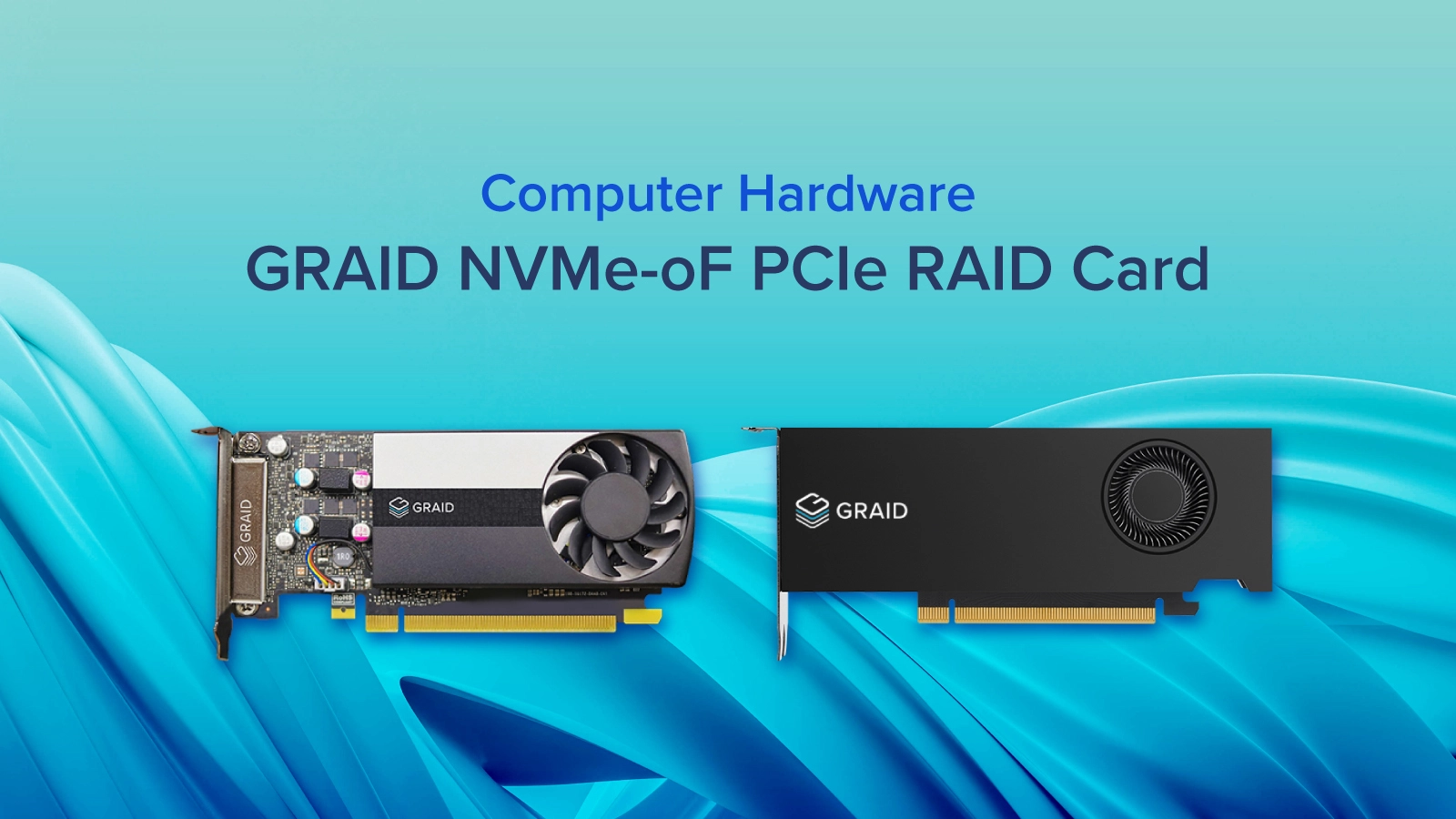
How to Reach Peak RAID Efficiency for NVMe SSDs
With significant storage advancements with NVMe SSDs, there hasn't been a scalable solution to add redundancy to your storage infrastructure while retaining the advantages of NVMe speeds and NVMe-oF (over-fabric) capabilities. NVMe storage has increased to an average of 7Gb/s, over 25 times faster than average HDD speeds. NVMe-oF allows the disaggregation from the CPU to enable a cloud-like storage infrastructure with minimal performance tradeoff.
Traditional RAID solutions revert modern-day NVMe SSD storage performance with bottlenecks and lack of scalability. Hardware RAID solutions require multiple RAID controllers into large server solutions with interface connectors that limit NVMe speeds and remove over-fabric aspects of NVMe-oF. Software RAID eliminates the need for additional resources and multiple RAID cards, but adds strain on the CPU, using valuable resources that could be utilized elsewhere. High-performing NVMe storage deserves a high-performing RAID solution.
GRAID Technology, headquartered in Silicon Valley with an office in Ontario, and an R&D center in Taipei, is breaking world records as the first NVMe RAID card to unlock the full potential of your SSD performance. GRAID Technology SupremeRAID™ revolutionizes the industry with a groundbreaking implementation of graphics cards.
Looking for a 1U or 2U GRAID Technology NVMe-oF Storage Solution?
Learn More about Exxact's GRAID NVMe Storage Solutions
What is RAID? What about Hardware and Software RAID?
RAID (Redundant Array of Independent Disks) is the process of increasing speed, providing redundancy, or a combination of both by spreading data or using parity calculations to drive failure recovery.
Hardware RAID speeds are great for HDD and sufficient for the SAS SSD storage but for NVMe, RAID speeds can't keep up. Two enterprise-level NVMe SSDs consume an entire hardware RAID card’s capacity equaling 12 to 16 RAID cards per rack, a horrendous solution for scalability not to mention all the cabling required if it were able to be pulled off.
Software RAID was used in an attempt to alleviate these issues. RAID configurations like RAID5 and RAID6 require parity calculations that write instructions on drives on how to recover a lost drive. However, these calculations were allocated to the CPU. Software RAID was a step backward putting an immense load on the CPU, the main reason for hardware RAID to exist in the first place. This meant that data infrastructures had to sacrifice valuable and expensive CPU resources to keep their data safe. Storage infrastructures just had to deal with allocating an entire data center CPU just for RAID.
The future of storage is growing faster and faster. NVMe has brought generational leaps in performance and will continue as new technology is discovered. Any storage infrastructure faces a huge risk when storage drives fail without having RAID protection. How can storage infrastructures ask for security without compromising speed and resources?
GRAID Technology SupremeRAID: One Solution; Massive Impact
GRAID Technology turned to graphics cards to solve this problem. Graphics Cards inherently hold tremendous computational prowess when executing repetitive calculations (like those found in evaluating graphics geometry). By installing a virtual NVMe controller and their retooled NVIDIA workstation GPU coupled with their AI engine, the GRAID Technology SupremeRAID handles all RAID operations from start to end.
GRAID Technology SupremeRAID directs the read/writes while avoiding PCIe speed bottlenecks and is responsible for evaluating the pesky RAID calculations, freeing up CPU resources. No storage data will ever run through the SupremeRAID card cutting out the middleman. Everything is done directly from memory to storage, clean and simple--one slot, no cables, no additional pass-throughs, no fuss, just a little GRAID Technology card acting as a foreman in the data storage infrastructure. GRAID Technology delivers power, flexibility, scalability, and user-friendliness in a single PCIe card.
GRAID Technology has teamed up with us at Exxact to be the first to stock the SupremeRAID SR-1000 and SupremeRAID SR-1010 as a component and software solution for 4, 8, 16, and 32 drive configurations. We also offer turnkey server solutions for those looking to build their NVMe storage infrastructure.
Installation and Performance
Installation is plug-and-play, slotting in an open PCIe slot just like a graphics card and entering a few lines of code similar to setting up a normal software RAID array. GRAID Technology has an excellent documentation guide for setup. Each GRAID Technology card supports up to 32 directly attached SSDs, more than enough for the industry standard 24 NVMe drive bay racks. GRAID Technology has worked hard to first deploy on Linux and now supports Windows Server 2022.
GRAID Technology offers two SupremeRAID cards: their first-generation PCIe Gen 3 SR-1000 based on the NVIDIA T1000 and their second-generation PCIe Gen 4 SR-1010. GRAID Technology SupremeRAID SR-1000 and SupremeRAID SR-1010 claimed benchmarks are shown below from the GRAID Technology website.
GRAID Technology’s solution removes CPU workload, an immense advantage over traditional RAID. It's safe to say SupremeRAID demolishes any other RAID solutions currently available.
Other Notable Distinctions
There are a couple of real-world reviews on these little GRAID Technology cards that showcase their performance. Check out Storage Review and Linus Tech Tips review on the GRAID Technology SR-1000. LTT saw the GRAID Technology SR-1000 push their 12 Kioxia CD6 NVMe drives at almost 1M IOPs for a near-perfect scaling and reaching peak NVMe SSD performance. Storage Review highlights the GRAID Technology SR-1000’s fantastic 11MB/s write speeds on their Intel P5510 Gen 4 SSDs, almost 10 times the speed of the software RAID they tested. GRAID Technology SupremeRAID cards all support NVMe-oF (over-Fabric). NVMe-oF enables the disaggregation of storage from the host to develop Software Composable Infrastructures (SCI). SCIs allow JBODs to be placed elsewhere while data is transferred over a highspeed fabric or fiber network with negligible performance decrease. With GRAID Technology SupremeRAID in tandem, RAID arrays can be created, accessed, and configured over NVMe-oF providing cloud-like advantages at bare-metal speeds. GRAID Technology is backed by Gigabyte, Kioxia, Western Digital, Seagate, AMD, us at Exxact, and many more. They received the CES Innovation Award in 2022, won the Data Center World Startup Challenge, and named Top 10 Data Storage Startups. The engineers at GRAID Technology are working tirelessly to deliver top-tier performance for the storage industry.
Conclusion
The GRAID Technology SupremeRAID solution offers meaningful performance for infrastructures accessing on NVMe drives. It’s great for video editing and footage ingest, exceptional for AI training, and perfect for storage infrastructures looking for some extra redundancy. GRAID Technology didn't make a new run-of-the-mill Hardware RAID card or spoof some programming magic for another CPU-hungry Software RAID. Taking elements of both processes and introducing the use of graphic acceleration, GRAID Technology has developed something truly special. In addition to being the first to stock the SupremeRAID SR-1000 and SupremeRAID SR-1010 as a component and software solution for 4, 8, 16, and 32 drive configurations, Exxact also worked with GRAID Technology to build a turnkey NVMe solution in our TensorEX 1U and TensorEX 2U NVMe-oF storage solutions to help jump-start your storage infrastructure needs. If you’re going to make investments in faster storage, there’s no better way than to start using GRAID Technology SuperRAID.
Have any Questions?
Contact Exxact Today

GRAID Technology NVMe-oF PCIe RAID Card
How to Reach Peak RAID Efficiency for NVMe SSDs
With significant storage advancements with NVMe SSDs, there hasn't been a scalable solution to add redundancy to your storage infrastructure while retaining the advantages of NVMe speeds and NVMe-oF (over-fabric) capabilities. NVMe storage has increased to an average of 7Gb/s, over 25 times faster than average HDD speeds. NVMe-oF allows the disaggregation from the CPU to enable a cloud-like storage infrastructure with minimal performance tradeoff.
Traditional RAID solutions revert modern-day NVMe SSD storage performance with bottlenecks and lack of scalability. Hardware RAID solutions require multiple RAID controllers into large server solutions with interface connectors that limit NVMe speeds and remove over-fabric aspects of NVMe-oF. Software RAID eliminates the need for additional resources and multiple RAID cards, but adds strain on the CPU, using valuable resources that could be utilized elsewhere. High-performing NVMe storage deserves a high-performing RAID solution.
GRAID Technology, headquartered in Silicon Valley with an office in Ontario, and an R&D center in Taipei, is breaking world records as the first NVMe RAID card to unlock the full potential of your SSD performance. GRAID Technology SupremeRAID™ revolutionizes the industry with a groundbreaking implementation of graphics cards.
Looking for a 1U or 2U GRAID Technology NVMe-oF Storage Solution?
Learn More about Exxact's GRAID NVMe Storage Solutions
What is RAID? What about Hardware and Software RAID?
RAID (Redundant Array of Independent Disks) is the process of increasing speed, providing redundancy, or a combination of both by spreading data or using parity calculations to drive failure recovery.
Hardware RAID speeds are great for HDD and sufficient for the SAS SSD storage but for NVMe, RAID speeds can't keep up. Two enterprise-level NVMe SSDs consume an entire hardware RAID card’s capacity equaling 12 to 16 RAID cards per rack, a horrendous solution for scalability not to mention all the cabling required if it were able to be pulled off.
Software RAID was used in an attempt to alleviate these issues. RAID configurations like RAID5 and RAID6 require parity calculations that write instructions on drives on how to recover a lost drive. However, these calculations were allocated to the CPU. Software RAID was a step backward putting an immense load on the CPU, the main reason for hardware RAID to exist in the first place. This meant that data infrastructures had to sacrifice valuable and expensive CPU resources to keep their data safe. Storage infrastructures just had to deal with allocating an entire data center CPU just for RAID.
The future of storage is growing faster and faster. NVMe has brought generational leaps in performance and will continue as new technology is discovered. Any storage infrastructure faces a huge risk when storage drives fail without having RAID protection. How can storage infrastructures ask for security without compromising speed and resources?
GRAID Technology SupremeRAID: One Solution; Massive Impact
GRAID Technology turned to graphics cards to solve this problem. Graphics Cards inherently hold tremendous computational prowess when executing repetitive calculations (like those found in evaluating graphics geometry). By installing a virtual NVMe controller and their retooled NVIDIA workstation GPU coupled with their AI engine, the GRAID Technology SupremeRAID handles all RAID operations from start to end.
GRAID Technology SupremeRAID directs the read/writes while avoiding PCIe speed bottlenecks and is responsible for evaluating the pesky RAID calculations, freeing up CPU resources. No storage data will ever run through the SupremeRAID card cutting out the middleman. Everything is done directly from memory to storage, clean and simple--one slot, no cables, no additional pass-throughs, no fuss, just a little GRAID Technology card acting as a foreman in the data storage infrastructure. GRAID Technology delivers power, flexibility, scalability, and user-friendliness in a single PCIe card.
GRAID Technology has teamed up with us at Exxact to be the first to stock the SupremeRAID SR-1000 and SupremeRAID SR-1010 as a component and software solution for 4, 8, 16, and 32 drive configurations. We also offer turnkey server solutions for those looking to build their NVMe storage infrastructure.
Installation and Performance
Installation is plug-and-play, slotting in an open PCIe slot just like a graphics card and entering a few lines of code similar to setting up a normal software RAID array. GRAID Technology has an excellent documentation guide for setup. Each GRAID Technology card supports up to 32 directly attached SSDs, more than enough for the industry standard 24 NVMe drive bay racks. GRAID Technology has worked hard to first deploy on Linux and now supports Windows Server 2022.
GRAID Technology offers two SupremeRAID cards: their first-generation PCIe Gen 3 SR-1000 based on the NVIDIA T1000 and their second-generation PCIe Gen 4 SR-1010. GRAID Technology SupremeRAID SR-1000 and SupremeRAID SR-1010 claimed benchmarks are shown below from the GRAID Technology website.
GRAID Technology’s solution removes CPU workload, an immense advantage over traditional RAID. It's safe to say SupremeRAID demolishes any other RAID solutions currently available.
Other Notable Distinctions
There are a couple of real-world reviews on these little GRAID Technology cards that showcase their performance. Check out Storage Review and Linus Tech Tips review on the GRAID Technology SR-1000. LTT saw the GRAID Technology SR-1000 push their 12 Kioxia CD6 NVMe drives at almost 1M IOPs for a near-perfect scaling and reaching peak NVMe SSD performance. Storage Review highlights the GRAID Technology SR-1000’s fantastic 11MB/s write speeds on their Intel P5510 Gen 4 SSDs, almost 10 times the speed of the software RAID they tested. GRAID Technology SupremeRAID cards all support NVMe-oF (over-Fabric). NVMe-oF enables the disaggregation of storage from the host to develop Software Composable Infrastructures (SCI). SCIs allow JBODs to be placed elsewhere while data is transferred over a highspeed fabric or fiber network with negligible performance decrease. With GRAID Technology SupremeRAID in tandem, RAID arrays can be created, accessed, and configured over NVMe-oF providing cloud-like advantages at bare-metal speeds. GRAID Technology is backed by Gigabyte, Kioxia, Western Digital, Seagate, AMD, us at Exxact, and many more. They received the CES Innovation Award in 2022, won the Data Center World Startup Challenge, and named Top 10 Data Storage Startups. The engineers at GRAID Technology are working tirelessly to deliver top-tier performance for the storage industry.
Conclusion
The GRAID Technology SupremeRAID solution offers meaningful performance for infrastructures accessing on NVMe drives. It’s great for video editing and footage ingest, exceptional for AI training, and perfect for storage infrastructures looking for some extra redundancy. GRAID Technology didn't make a new run-of-the-mill Hardware RAID card or spoof some programming magic for another CPU-hungry Software RAID. Taking elements of both processes and introducing the use of graphic acceleration, GRAID Technology has developed something truly special. In addition to being the first to stock the SupremeRAID SR-1000 and SupremeRAID SR-1010 as a component and software solution for 4, 8, 16, and 32 drive configurations, Exxact also worked with GRAID Technology to build a turnkey NVMe solution in our TensorEX 1U and TensorEX 2U NVMe-oF storage solutions to help jump-start your storage infrastructure needs. If you’re going to make investments in faster storage, there’s no better way than to start using GRAID Technology SuperRAID.
Have any Questions?
Contact Exxact Today

